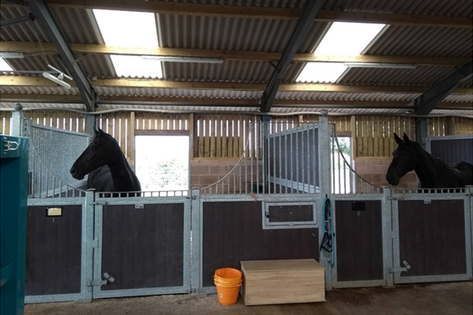It all starts with that sinking feeling as you bring your horse in from the field and notice the swollen leg or gaping cut (insert raft of possibilities here…). On further investigation, the vet is called and the depressing verdict given – box rest. Invariably, any form of equine rehabilitation will start with a period of box rest following injury or operation and can be anything from a few days to several months, depending on the trigger. How you and your horse cope with this can have a huge effect on the program going forward.
Most people would agree that keeping a horse in confined space 24/7 is not good for either their physical or mental health. However, sometimes it’s a necessary evil – horses won’t follow the vet’s advice to limit movement to avoid further damage, so confinement may be the only option!
Some points about box rest;
-
How confined the horse needs to be will depend on the cause for rest. This could range from an extended stable pen to using cross ties – follow your vet’s advice.
-
Acute issues, such as fractures and laminitis, may require more extreme limitation of movement.
-
Box rest is often recommended when there is a suspected soft tissue injury in order to minimise further damage, whilst helping to decrease swelling and inflammation, to enable further, more accurate assessment.
-
Box rest is also likely to be advised when a horse is in recuperation following surgery where dressings/stitches need to be monitored or changed.
1. Stable/Environment
Consider the immediate environment for the horse. The more settled/acceptant the horse is, the better equipped they’ll be to move on to the next stage of rehabilitation. It will not always be possible to provide the ideal, so look at ways to adapt and overcome. If necessary, consider sending your horse to a specialist facility.
-
The size of the stable required will depend on how much movement is allowed – not so large that the horse can get up to mischief but not so small that movement is limited excessively. Again, follow your vet’s advice – the space may need to start small but increase as rehabilitation progresses.
-
If the horse is confined 24/7 then good ventilation is imperative to avoid respiratory complications. Whilst American barn arrangements are common, ideally there should be a window/door open to the fresh air outside. This also adds interest for the horse. Take into consideration that some horses may not be permitted to move out of their box at all, so good airflow is even more important.
-
 Can some outdoor space be incorporated?
Can some outdoor space be incorporated?
-
Some horses will like lots of activity – to watch people and horses coming and going –whereas some horses will find this unsettling. Depending on the preference of your horse, consider the possibility of using alternative stables to accommodate their needs. If permitted, have a separate day and night stable to provide variety.
-
Sadly, your bedding costs will increase. Again, your vet can advise but different types of bedding can work better for different reasons. For example, deep shavings are preferable for cases of laminitis, with a full covering on the stable floor to support feet. Other cases may want minimal, lightweight bedding to avoid the extra force created on their limbs by dragging it around. When selecting bedding, consider the horse’s habits and bedding properties (dust levels, absorbency, box walking and tastiness). If a full bed is not required, rubber or EVA matting can help keep costs and time commitments down, however, you should always ensure there is at least enough bedding for urine absorption and your horse to lie down comfortably. A deep straw bed may look inviting and encourage the horse to lie down but its palatability can cause other problems, such as impactions.
2. Diet
Ideally you would be able to feed ad-lib, but it’s often necessary to restrict calories so this may not always be possible.
-
Lots of small feeds – include a feed balancer.
-
Feed them soaked hay, double netted if using haynets.
-
Consider hay substitutes, such as chopped straw.
-
Even if ad-lib hay is permitted, getting small portions more frequently helps break up the day and ‘new’ hay is more desirable than being left with same net all day, especially if soaked.
-
Monitor the horse carefully, check their droppings (number/consistency) and bedding (unusual disturbance), and adjust their diet accordingly.
3. Companionship
If your horse is normally kept on their own, whilst not ideal, they will possibly cope better in a restricted box rest situation. For others, separation anxiety may set in. The ability to provide company at all times will depend on the circumstances, as yards will have their own routines and it may be difficult to keep horses in.

-
Consider how much interaction your horse would like – horses are individuals, some prefer their own space. Is it enough for them to see/touch between grills or would they be happier if they could nuzzle/groom over a fence?
-
Having at least one other horse visible will help lower anxiety. This may be easier in the winter or in a yard where turnout is not generally 24/7 and more difficult in summer when horses are generally able to spend more time outside. Speak to others on the yard to see if a rota can be arranged.
-
Would your horse be content with non-equine companions? Sheep, goats and chickens could all provide some much needed company.
4. Breaking the boredom
A companion can go a long way to keeping a horse settled but 24 hours is a lot of time to fill! To try and prevent vices and aggression developing, think of ways to occupy them that don’t involve destroying things (think dressings, bandages, rugs, mats, expensive kit, wood, hay bars…)

-
Stable toys: There are many products on the market designed to entertain horses – some fulfil the need to forage and make feed last longer, some test their dexterity. What you provide depends on your horse, e.g. if they are liable to get over excited and buck/charge round the stable, it’s probably best not to give them ball toys on the floor.
-
Fruit and fibre offer healthy options: Swede on a rope (*warning – hard on head*), carrots hidden in a haynet, apple-bobbing and half a water melon have all been suggested.
-
Feed in a device designed to promote trickle feeding or throw fibre nuts etc on the floor for them to forage.
-
A stable mirror may help, particularly in the absence of a companion.
-
Provide a routine. During rehabilitation horses generally settle into a routine whether that is 24/7 box rest or short in-hand walks. Changes in routine can cause disruption and stress, e.g. moving on to the next stage of rehab, different feed times, other horses being turned out/in at different times.
-
Spend time with your horse. Grooming and massaging will mostly be appreciated and gives you a chance to spot any subtle changes.
-
If there are other people coming and going, enlist their help so treats/entertainment can be spread throughout the day – they can pop in that extra haynet/treatball or throw nuts on floor etc.
5. Maintaining condition/strength
Horses on box rest will start to lose fitness and condition after 1-2 weeks, depending on levels prior to confinement. There is also increased risk of legs filling and impaction due to lack of movement. You should aim to keep the body as ready as possible for next stage of rehabilitation – minimising loss of muscle tone, flexibility and bone strength/density.
-
 General grooming not only removes dust and scurf from the coat but gives you an opportunity to monitor their condition and behaviour.
General grooming not only removes dust and scurf from the coat but gives you an opportunity to monitor their condition and behaviour.
-
Strapping is a cheap and effective way to help maintain large muscle groups.
-
Bandaging can help reduce swelling in legs.
-
Carrot stretches/exercises help maintain muscle tone and flexibility – speak to your vet and physio to check what is appropriate.
-
Massage pads/rugs can also aid with maintaining muscle tone and flexibility, as well as calming and relaxing.
-
Regular physiotherapy/massage will help pinpoint and relieve areas of soreness and compensatory issues.
-
Therapeutic equipment and practices, such as Transcutaneous Electrical Nerve Stimulation (TENS), Neuromuscular Electrical Stimulation (NMES), Pulsed Electromagnetic Field Therapy (PEFM), therapeutic ultrasound, cryotherapy, cold laser and vibration therapy, can aid in pain relief, swelling reduction and may offset some of the muscle/bone loss due to inactivity.
While some horses turn into unrecognisable lunatics, a surprising number will accept the new routine. If your horse falls into the former category, don’t hesitate to talk to your vet regarding the use of sedatives or alternative arrangements. If the horse becomes dangerous towards you or themselves, the value of the box rest is questionable and it may be worth seeking professional assistance. By considering the physiological and psychological needs of your horse, there is a greater chance of having a calm but still engaged horse. Coupled with minimal loss of condition, they should be ready to move onto the next stage of their rehabilitation.


 Can some outdoor space be incorporated?
Can some outdoor space be incorporated? 

 General grooming not only removes dust and scurf from the coat but gives you an opportunity to monitor their condition and behaviour.
General grooming not only removes dust and scurf from the coat but gives you an opportunity to monitor their condition and behaviour.
